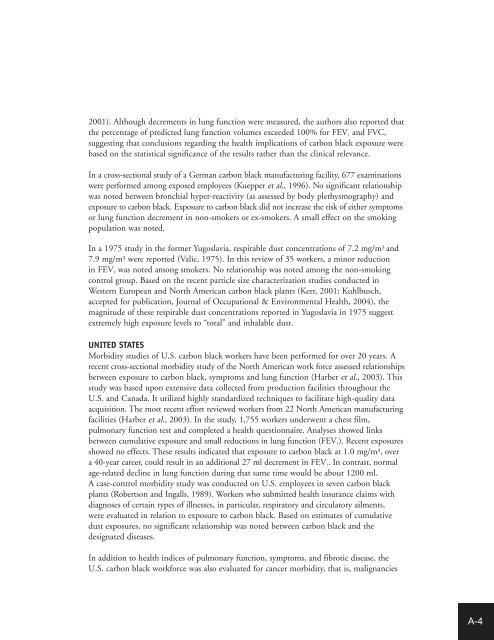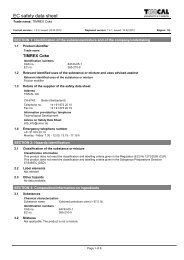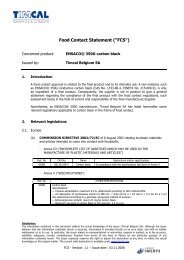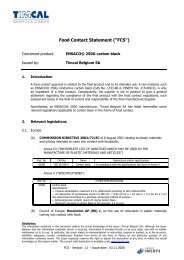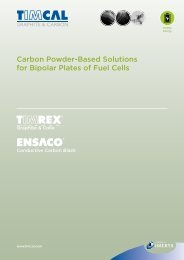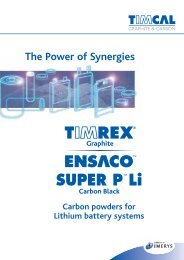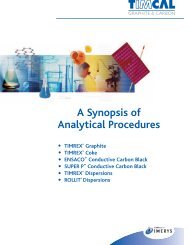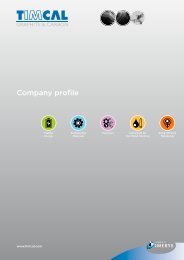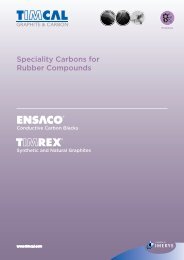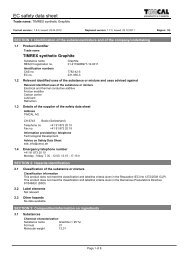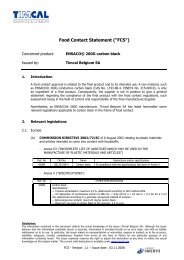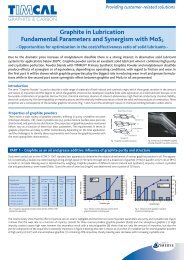Carbon Black Users Guide - Timcal
Carbon Black Users Guide - Timcal
Carbon Black Users Guide - Timcal
You also want an ePaper? Increase the reach of your titles
YUMPU automatically turns print PDFs into web optimized ePapers that Google loves.
2001). Although decrements in lung function were measured, the authors also reported thatthe percentage of predicted lung function volumes exceeded 100% for FEV 1 and FVC,suggesting that conclusions regarding the health implications of carbon black exposure werebased on the statistical significance of the results rather than the clinical relevance.In a cross-sectional study of a German carbon black manufacturing facility, 677 examinationswere performed among exposed employees (Kuepper et al., 1996). No significant relationshipwas noted between bronchial hyper-reactivity (as assessed by body plethysmography) andexposure to carbon black. Exposure to carbon black did not increase the risk of either symptomsor lung function decrement in non-smokers or ex-smokers. A small effect on the smokingpopulation was noted.In a 1975 study in the former Yugoslavia, respirable dust concentrations of 7.2 mg/m 3 and7.9 mg/m 3 were reported (Valic, 1975). In this review of 35 workers, a minor reductionin FEV 1 was noted among smokers. No relationship was noted among the non-smokingcontrol group. Based on the recent particle size characterization studies conducted inWestern European and North American carbon black plants (Kerr, 2001; Kuhlbusch,accepted for publication, Journal of Occupational & Environmental Health, 2004), themagnitude of these respirable dust concentrations reported in Yugoslavia in 1975 suggestextremely high exposure levels to “total” and inhalable dust.UNITED STATESMorbidity studies of U.S. carbon black workers have been performed for over 20 years. Arecent cross-sectional morbidity study of the North American work force assessed relationshipsbetween exposure to carbon black, symptoms and lung function (Harber et al., 2003). Thisstudy was based upon extensive data collected from production facilities throughout theU.S. and Canada. It utilized highly standardized techniques to facilitate high-quality dataacquisition. The most recent effort reviewed workers from 22 North American manufacturingfacilities (Harber et al., 2003). In the study, 1,755 workers underwent a chest film,pulmonary function test and completed a health questionnaire. Analyses showed linksbetween cumulative exposure and small reductions in lung function (FEV 1 ). Recent exposuresshowed no effects. These results indicated that exposure to carbon black at 1.0 mg/m 3 , overa 40-year career, could result in an additional 27 ml decrement in FEV 1 . In contrast, normalage-related decline in lung function during that same time would be about 1200 ml.A case-control morbidity study was conducted on U.S. employees in seven carbon blackplants (Robertson and Ingalls, 1989). Workers who submitted health insurance claims withdiagnoses of certain types of illnesses, in particular, respiratory and circulatory ailments,were evaluated in relation to exposure to carbon black. Based on estimates of cumulativedust exposures, no significant relationship was noted between carbon black and thedesignated diseases.In addition to health indices of pulmonary function, symptoms, and fibrotic disease, theU.S. carbon black workforce was also evaluated for cancer morbidity, that is, malignanciesA-4


